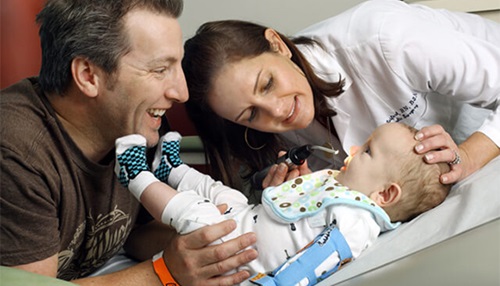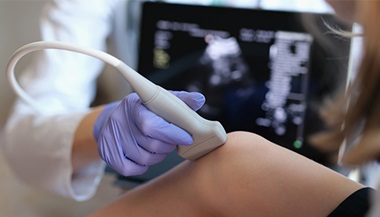Craniofacial Abnormalities
What You Need to Know Craniofacial Abnormalities
- Babies’ skulls consist of plates of bone, separated by soft areas called sutures. In the first six to 18 months of life, the sutures close (fuse) and the skull becomes one piece.
- Craniofacial malformations, including craniosynostosis, are the result of an infant’s skull or facial bones fusing together too soon or in an abnormal way.
- When the bones fuse together too early, the brain can become damaged as it grows and cannot expand properly, and the infant may develop neurological problems.
- Surgery may be necessary to revise the contours of the face and skull, and provide room for the baby’s growing brain.
Symptoms of Craniofacial Abnormalities
Craniofacial malformations can be mild or severe, and depend on what parts of the infant’s skull are affected. Certain groups of signs and symptoms are known as syndromes, and there are several that result in telltale facial anomalies:
Apert syndrome: A craniofacial abnormality characterized by an abnormal head shape, small upper jaw, and fusion of the fingers and toes.
Brachycephaly: A birth defect characterized by the disproportionate shortness of the head. It is caused by a premature fusing of the coronal suture. Brachycephaly is commonly associated with a number of syndromes, such as Apert, Crouzon, Pfeiffer, Saethre-Chotzen and Carpenter.
Crouzon syndrome: A birth defect characterized by abnormalities in the skull and facial bones, caused by a fusing of both sides of the coronal suture. This syndrome often causes the skull to be short in the front and the back. Flat cheek bones and a flat nose are also typical of this disorder.
Encephalocele: A condition characterized by a protrusion of the brain or its coverings through the skull.
Kleeblattschadel syndrome: A very rare birth defect characterized by abnormalities of the skull and facial bones. It is caused by a premature fusing of almost all of the fibrous sutures. It is also called cloverleaf skull.
Oxycephaly: A birth defect characterized by abnormalities in the skull and facial bones. This syndrome causes the top of the skull to be pointed or cone-shaped. It is caused by a premature fusing of the coronal and sagittal sutures. It is also known as turricephaly or high-head syndrome.
Pfeiffer syndrome: A birth defect characterized by abnormalities of the skull, hands, and feet. This syndrome results in wide-set, bulging eyes, an underdeveloped upper jaw, and a beaked nose due to the head being unable to grow normally.
Pierre Robin syndrome: A birth defect characterized by abnormalities in the facial bones, resulting in a smaller-than-normal lower jaw or receding chin. The tongue often falls back in the throat, causing difficulty breathing.
Plagiocephaly: A persistent flat spot on one side or on the back of a baby’s head caused by sleeping in the same position most of the time. This is a very common issue and affects about one in 10 infants in the U.S. Most infants show improvement with repositioning and exercises. Sometimes, plagiocephaly can start before birth and is more common in twins.
Saethre-Chotzen syndrome: A birth defect characterized by an unusually short or broad head. In addition, the eyes may be spaced wide apart, eyelids may be droopy, and fingers may be abnormally short and webbed.
Scaphocephaly: A long, narrow head shape resulting from early fusion of the sagittal suture, which runs front to back, down the middle of the top of the head.
Torticollis: A twisting of the neck that causes the head to rotate and tilt at an odd angle. It most often results from tightness of one of the neck muscles. Torticollis often responds very well to neck exercises. It is also known as wry neck.
Trigonocephaly: A triangular configuration of the skull caused by the premature fusion of the two halves of the frontal bones at the metopic suture, which extends down the middle of the forehead toward the nose.
Facebook Live: National Cleft and Craniofacial Awareness Month
Diagnosis of Craniofacial Abnormalities
Some of these syndromes are apparent at birth, while others are not obvious until a baby’s head grows larger over the first few months. Most of the time, your physician can identify a craniofacial abnormality by examination alone. Examining your child’s skull, brain and facial structure with an MRI or CT scan can help clarify the diagnosis.
Babies’ heads grow rapidly the first year of life, which is why early infancy is when these conditions are likely to be diagnosed and require treatment. Your pediatrician may recommend observation for a few weeks or months to see if you child’s condition is going to progress. You may be referred to a neurosurgeon, who can work with you to develop the most appropriate treatment plan for your child.
Treatment for Craniofacial Abnormalities
Craniofacial Surgery
For true craniosynostosis and other syndromes, your doctor may recommend surgery to correct the physical formation of the skull and facial bones, and maximize functionality for your child.
These surgeries can be complex and intensive, requiring removal, reshaping and replacing parts of the skull. Pediatric neurosurgeons may work with pediatric craniofacial plastic surgeons to ensure the best result.
Skull reconstruction may involve the surgeons using sutures, wires, small screws or plates to stabilize the bone and protect the brain as your child grows. These materials are often too small to be felt under the skin.
Minimally Invasive Surgery
In some cases, if your child’s anomaly is diagnosed before he or she is three months old, the surgical team may be able to use one of several minimally invasive procedures. These endoscopic approaches can lessen the risks of blood transfusions and complications compared to open surgery, and can also mean faster recovery for your child.
Minimally invasive operations may be followed with helmet therapy, in which your child wears a special helmet to gently guide the growing skull bones into position so they can fuse more normally.
Consult a specialist as soon as possible
In any case, time is of the essence, since babies’ brains grow quickly. Prompt evaluation with a specialist is essential to ensure your child has the full range of therapies available.
The Johns Hopkins Cleft and Craniofacial Center







